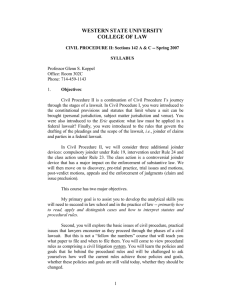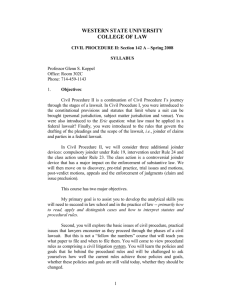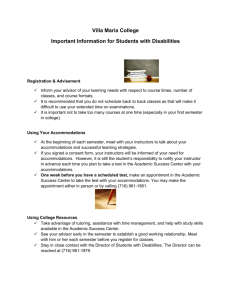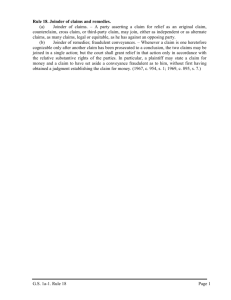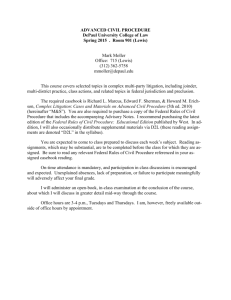Civil Procedure II 142 A and C - Prof. Koppel
advertisement
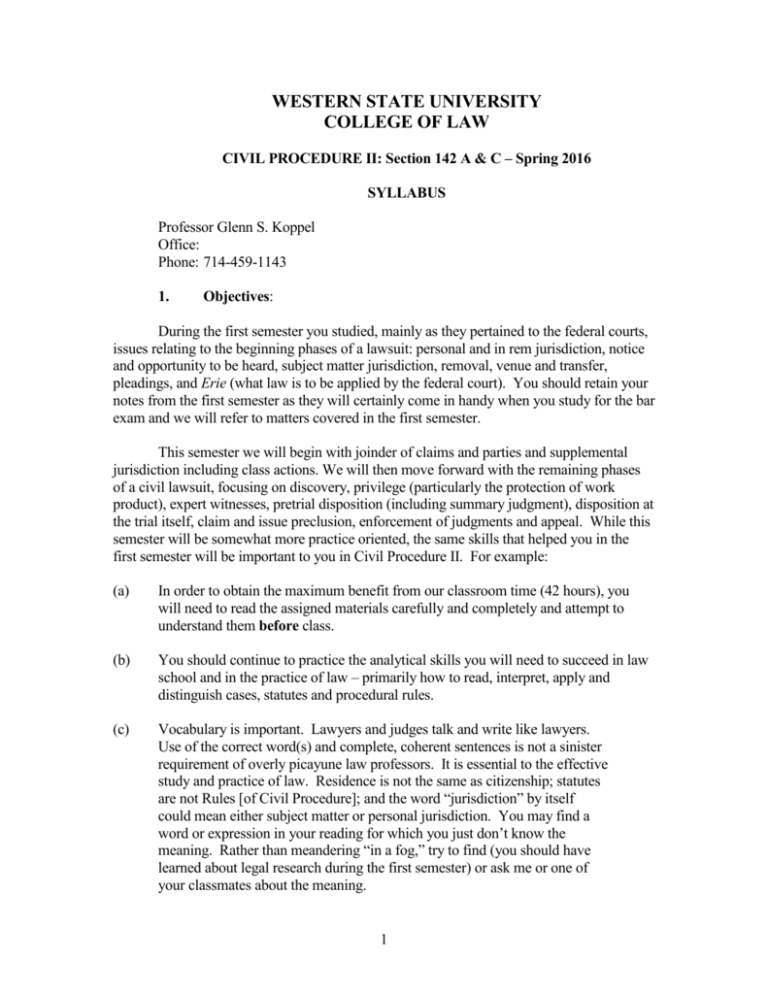
WESTERN STATE UNIVERSITY COLLEGE OF LAW CIVIL PROCEDURE II: Section 142 A & C – Spring 2016 SYLLABUS Professor Glenn S. Koppel Office: Phone: 714-459-1143 1. Objectives: During the first semester you studied, mainly as they pertained to the federal courts, issues relating to the beginning phases of a lawsuit: personal and in rem jurisdiction, notice and opportunity to be heard, subject matter jurisdiction, removal, venue and transfer, pleadings, and Erie (what law is to be applied by the federal court). You should retain your notes from the first semester as they will certainly come in handy when you study for the bar exam and we will refer to matters covered in the first semester. This semester we will begin with joinder of claims and parties and supplemental jurisdiction including class actions. We will then move forward with the remaining phases of a civil lawsuit, focusing on discovery, privilege (particularly the protection of work product), expert witnesses, pretrial disposition (including summary judgment), disposition at the trial itself, claim and issue preclusion, enforcement of judgments and appeal. While this semester will be somewhat more practice oriented, the same skills that helped you in the first semester will be important to you in Civil Procedure II. For example: (a) In order to obtain the maximum benefit from our classroom time (42 hours), you will need to read the assigned materials carefully and completely and attempt to understand them before class. (b) You should continue to practice the analytical skills you will need to succeed in law school and in the practice of law – primarily how to read, interpret, apply and distinguish cases, statutes and procedural rules. (c) Vocabulary is important. Lawyers and judges talk and write like lawyers. Use of the correct word(s) and complete, coherent sentences is not a sinister requirement of overly picayune law professors. It is essential to the effective study and practice of law. Residence is not the same as citizenship; statutes are not Rules [of Civil Procedure]; and the word “jurisdiction” by itself could mean either subject matter or personal jurisdiction. You may find a word or expression in your reading for which you just don’t know the meaning. Rather than meandering “in a fog,” try to find (you should have learned about legal research during the first semester) or ask me or one of your classmates about the meaning. 1 (d) The ability to apply cases, Rules and statutes to differing fact situations is critical. Imagination, as much as anything else, is what good lawyers get paid for. Sometimes, but not often, a proffered fact pattern will be exactly like the facts of a case or Rule or statute you have read. Exam questions are almost always variations of well known cases. And, of course, an essence of the practice of law is the ability to apply the appropriate law to the situation presented. “Civil Procedure” is highly controversial these days. The federal rules were originally intended to eliminate the formalist barriers to justice so that cases can be determined “on the merits.” Some critics contend that the liberal ethos of the federal rules has promoted a “litigation explosion” of baseless lawsuits that has clogged our courts and denied justice to all but the wealthiest litigants. These critics advocate more liberal use of summary judgment and arbitration to de-rail litigation out of court. The federal courts have responded by raising the pleading bar (see Twiqbal), making summary judgment a more powerful tool in the hands of defendants (see Anderson v. Liberty Lobby and Celotex) and by upholding “fine-print” mandatory arbitration provisions in consumer contracts that prohibit class action arbitration. Several years ago, Congress enacted the Class Action Fairness Act to cut back on class actions, a joinder device intended to empower persons who otherwise might be unable to enforce their rights in court. Others, however, argue that the “litigation explosion” is a myth created by wealthy “repeat-player” defendants to justify “fixing” the rules to make it easier to dismiss claims against them. Discovery is another bone of contention. Intended originally as a reform measure designed to level the playing field between rich and poor litigants, discovery - many experts believe - is out of control, abused by some litigators to achieve unfair tactical advantage in litigation. In response, a series of rules amendments over the years has chipped away at liberal discovery. As of December 2015, the discovery rules have once again been amended to address these perceived abuses. As you work your way through this course, ask yourself whether the federal rules have achieved the goals of securing the “just, speedy, and inexpensive determination of every action.” (Rule 1) 2. Required Texts: Freer & Perdue, Civil Procedure – Cases, Materials and Questions 6th ed., LexisNexis, 2008. Federal Rules of Civil procedure, Thomson Reuters, 2015-2016 Educational Edition. 2 3. Freer & Perdue, 2015 Update Memorandum: available online at http://www.lexisnexis.com/store/images/Supplements/35152015%20Supplement.pdf Certain week’s required assignments include a CALI online exercise. If you are not already registered with CALI, you should do so at “cali.org.” the Authorization Code is WESTNNstu235. Where a CALI exercise is required, you must provide me with a proof of completion. For instructions on how to do this, click onto “Saving Your CALI Lesson Score.” 4. Suggested Supplemental Reading: Glannon, Civil Procedure – Examples & Explanations,; 7th Edition, Aspen Law & Business 2008 (“Glannon Examples”). Glannon, The Glannon Guide to Civil Procedure, Aspen, 2013 3rd Edition (“The Glannon Guide”). Shreve & Raven-Hansen, Understanding Civil Procedure, 5th ed., LexisNexis. Friedenthal, Kane & Miller, Hornbook on Civil Procedure, 4th ed., West, 2005. "In-Class" Methodology: The centerpiece of this course will continue to be Federal Rules of Civil Procedure [hereinafter, “F.R.C.P.”] which is the code of procedure applicable in civil litigation in federal court and which has been adopted by many state courts (but not California). However, Civil Procedure law is derived from a wide variety of primary legal authority besides the F.R.C.P. For example, the right to a civil jury trial flows from the Seventh Amendment to the U.S. Constitution. The right to appeal a judgment is, in part, defined by congressional statute (28 U.S.C.§§1291 and 1292). But even where an F.R.C.P. or statute or constitutional provision governs a particular procedural issue, the relevant text must be interpreted by courts on a caseby-case basis. Therefore, although this course deals with “procedural rules," we will, nevertheless, heavily employ the same “case method” with which you have already become somewhat familiar in your “substantive” courses (i.e., contracts and torts). To prepare for class, you must read the assigned materials carefully and brief all cases (not including note cases). Book briefing is not acceptable. When, during the course of your assigned reading, you encounter references to an F.R.C.P. or a federal statute or a constitutional provision, you are required, as part of your preparation for class, to look up these legal sources in your supplement and read them carefully. Also, most of the F.R.C.P.s in the 3 supplement are followed by Advisory Committee Notes, which is the F.R.C.P. equivalent of the “legislative history” behind the rules. These Notes are a valuable resource to help you to understand the rules and you are, therefore, required, as part of your preparation for class, to read these carefully as well. Effective December 2015, certain discovery rules have been amended. You are required to carefully note the changes wrought by these amendments and their effect on access to discovery. 5. Exams and Grading There will be a graded mid-term exam (probably essay format) and a final examination consisting of multiple choice questions, possibly some short answer questions and an essay question. Each student will receive a numeric final course grade which will consist of the sum of 15% of the mid-term grade and 85% of the final examination grade. Practice exams and issue analyses are available on my course website. DO NOT WAIT UNTIL THE END OF THE SEMESTER TO BEGIN TAKING PRACTICE EXAMS. I am available during my regularly scheduled office hours to discuss with you your answers to practice exams. But, before seeing me, make sure that you have first compared your answer to a given practice exam with my issue analysis so that we can make the most efficient use of our time together. 6. Classroom Participation Legal education is a cooperative venture. Each of you must be prepared to participate in class on a regular basis. If you are unprepared, you will be deemed “absent” for that class session. PLEASE NOTE: THERE IS A SIGNIFICANT DIFFERENCE BETWEEN BEING UNPREPARED AND BEING UNABLE TO ANSWER A PARTICULAR QUESTION. No one knows the answer to every law-related question. You will not be down-graded for venturing an incorrect answer so long as it is clear that you have read the assigned material and briefed the assigned cases. 7. Attendance & Decorum Successful completion of this course is dependent upon satisfaction of the W.S.U. Attendance Policy which is reprinted in the Student Handbook. I will take attendance at the beginning of each class. If you arrive late or depart early you will be marked absent for that session. Late arrivals must not sign the sign-in sheet. 4 For the daytime classes, a student may miss no more than three (3) class sessions. For the evening classes, a student may miss no more than two (2) class sessions. ALSO BE AWARE THAT, PURSUANT TO W.S.C.L.'S ATTENDANCE POLICY, STUDENTS CANNOT MAKE UP AN ABSENCE BY ATTENDING ANOTHER PROFESSOR'S CLASS. Students' leaving and returning to their seats while class is in session is a major distraction for other students as well as for myself. Therefore, once class begins, students may not leave the classroom prior to the end of the class session unless you have notified the Dean of Students in advance that you have a particular physical condition that renders you unable to comply with this rule. Violation of this rule may be deemed an "early departure" for which a student may be marked absent 9. Seating Chart A seating chart will be distributed at the beginning of the second class session. Please print your name legibly in the seat you choose for your permanent seat. If you wish to change your seat, please notify me so that I can make the appropriate changes on the chart. 10. Office Hours: Please make appointments through the Faculty Appointments Book located at the receptionist desk on the third floor. My office hours will be posted in this book. If you cannot make a scheduled appointment, please notify me or my secretary that you are canceling your appointment as soon as possible so that another student can see me during that time slot. I will also be available the rest of the week as time permits. 11. Course Web Page: The course will have its own webpage on Lexis-Nexis’ Blackboard platform. You will need a Lexis ID number to access the webpage. To access the webpage, go to http://webcourses.lexisnexis.com/. The course webpage includes chat sub-groups, instructional objectives for every topic that is a part of this course, downloadable outlines of every topic to help you organize your lecture notes, links to the online quizzes, “think aloud” demonstrations of the legal analysis skills you are expected to develop in this course and other helpful information and links. Click on the “Course Information” button to learn about the course webpage and how you can use it to enhance your learning. 12. DISABILITY SERVICES STATEMENT: Western State College of Law provides accommodations to qualified students with disabilities. The Disabilities Services Office assists qualified 5 students with disabilities in acquiring reasonable and appropriate accommodations and in supporting equal access to services, programs, and activities at Western State College of Law. To seek reasonable accommodations, a student must contact Senior Assistant Dean Donna Espinoza, Student Services Director and Disabilities Services Coordinator, whose office is in the Second Floor Students Services Suite. Dean Espinoza’s phone number and email address are: (714) 459-1117; despinoza@wsulaw.edu. When seeking accommodations, a student should notify Dean Espinoza of her or his specific limitations and, if known, her or his specific requested accommodations. Students who seek accommodations will be asked to supply medical documentation of the need for accommodation. Classroom accommodations are not retroactive, but are effective only upon the student sharing approved accommodations with the instructor or professor. Therefore, students are encouraged to request accommodations as early as feasible with Dean Espinoza to allow for time to gather necessary documentation. If you have a concern or complaint in this regard, please notify Dean Espinoza; or please notify Associate Dean of Students Charles Sheppard at csheppard@wsulaw.edu or (714) 459-1152. Complaints will be handled in accordance with the College of Law’s “Policy against Discrimination and Harassment.” Reading Assignments The Scope of Litigation: Joinder of Parties and Claims Continued from Civil Procedure I WEEK 1 Claims Joinder: By Plaintiffs & Related Supplemental Jurisdiction Issues Required: F&P 667 – 691 FRCP 18 & 20 CALI Exercise: “Joinder of Claims and Parties” Recommended: Glannon Examples, 253 – 270 (Rules 18 and 20); 309 – 344 (Supplemental Jurisdiction) WEEK 2 Claims Joinder: By Defendants & Related Supplemental Jurisdiction Issues Counter-claims 6 Cross-claims Impleader (Third-Party Practice) Required: F&P 692 – 719 FRCP 13(a), (b) & (g); FRCP 14 Recommended: Glannon Examples, 253 – 270; 271 – 282 (FRCP 14) WEEK 3 I. Compulsory Joinder (Necessary and Indispensable Parties) Required: F&P 719 - 730 Rule 19 Recommended: Glannon Examples, 283-307 II. Intervention Required: F&P 730 – 735; Rule 24 III. Interpleader Required: F&P 737 – 752 Rule 22 28 U.S.C. §§1335, 1397, and 2361 CALI Exercise: “Interpleader” Suggested for review of Jurisdiction & Joinder: Glannon Examples, 333 - 346 WEEK 4 IV. The Class Action A. Introduction Required: F&P 753 – 756 Read the following law review article: John Bronsteen and Owen Fiss, The Class Action Rule, 78 Notre Dame Law Review 1419 (August 2003). B. Constitutional Considerations Required: F&P 756 – 762 C. Mechanics of Rule 23 Required: F&P 763 – 777 Rule 23 Jurisdictional Considerations Required: F&P 777 – 792 28 USC 1453; 28 USC 1332(d) D. 7 Discovery Preparation for Trial, Summary Judgment and/or Settlement WEEK 5 I. Introduction Required: F&P 361 – 364; CALI Exercise – “The Discovery Game” Recommended: Glannon – Examples & Explanations 409 – 410; CALI Exercise: “Woburn: A Game of Discovery” (No “proof of completion” required.) II. Discovery Devices Recommended: Glannon Examples 435 – 471 A. Mandatory Initial Disclosures Required: F&P 364 Rule 26(a)(1) B. Depositions Required: F&P 365 – 366 Rules 27, 28(a) and (c), 30, 31, and 32 C. Interrogatories Required: F&P 366 - 367 Rule 33 D. Production of Documents and Things Required: F&P 367 Rule 34 E. Medical Examination Required: F&P 367 - 368 Rule 35 F. Requests for Admission Required: 368 Rule 36 8 III. Scope of Discovery Recommended: Glannon Examples 409 – 434 A. General Scope: 2015 Amendments and Discovery of ESI Required: F&P 369 – 388 Rule 26(b)(1) and (2) WEEK 6 B. Privilege Required: F&P 388 – 391 C. Work Product Required: F&P 391 – 404 Rule 26(b)(3) WEEK 7 D. Experts Required: F&P 404 – 413 E. Review Problem: F&P 415 – 416 IV. Timing, Pretrial Disclosures, and Conferences Required: F&P 416 – 421 V. Discovery Sanctions Required: Rules 26(g) and 37 Judgment and Beyond WEEK 8 9 I. The Right to a Jury Under the Seventh Amendment Required: F&P 439 – 460 7th Amendment of the U.S. Constitution WEEK 9 II. Pre-Trial Disposition: Summary Judgment Required: F&P 487 – 508 CALI Exercise: “Summary Judgment” Read the following law review article: Glenn S. Koppel, The California Supreme Court Speaks Out on Summary Judgment In Its Own “Trilogy” of Decisions: Has the Celotex Era Arrived?, 42 Santa Clara L. Rev. 483 (2002) Rule 56 Recommended: Glannon Examples 473 – 494 WEEK 10 III. Disposition at Trial: Recommended: Glannon Examples 495 – 538 A. Judgment as a Matter of Law Required: F&P 508 – 517 Rule 50 CALI Exercise: “Judgments as a Matter of Law” Recommended: The Glannon Examples, 495 - 521 B. New Trial and Relief from Judgment Required: F&P 518 – 527; 531 - 532 Rules 59 and 60(b) Recommended: The Glannon Examples, 521 - 537 WEEKS 11 - 13 IV. Preclusive Effects of Prior Judgments A. Introduction Required: F&P 613 – 615 CALI Exercise: “Preclusion” 10 B. Claim Preclusion (Res Judicata) Required: F&P 615 – 632 Recommended: Glannon Examples 541 – 576 C. Issue Preclusion (Collateral Estoppel) Required: F&P 632 – 662. Recommended: Glannon Examples 577 – 613 D. Problems of Federalism Required: F&P 662 – 665 WEEK 14 V. Appeal Required: F&P 793 - 812. 11
